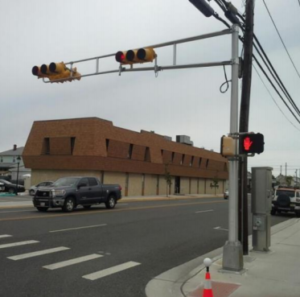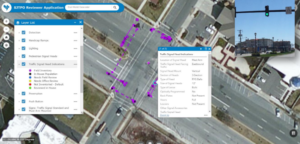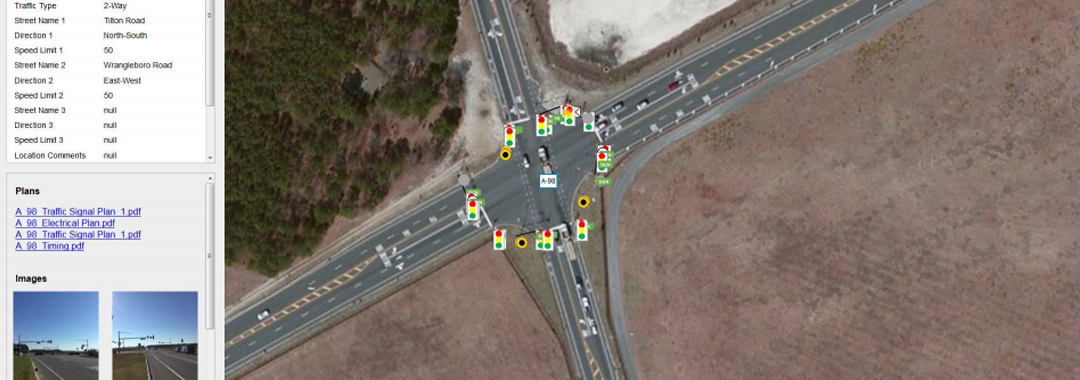As technology advances, so does the need for data—information that allows engineers, planners, and others to utilize innovative ways to improve transportation and safety. To implement smart traffic systems, whereby centrally controlled traffic signals and sensors regulate the flow of traffic, agencies must know the present state of their traffic signal infrastructure. The South Jersey Transportation Planning Organization (SJTPO), the metropolitan planning organization for four counties in South Jersey, sought to better understand their infrastructure by developing a database of all traffic signals in the region. Completed in 2017, the database provides local agencies with the information needed to target intersections and signals for upgrades and replacements. Replacement with newer integrated traffic signals improves traffic flow, allows for remote signal monitoring and regional signal maintenance, and supports bicycle and pedestrian improvements at intersections.

A traffic signal located in SJTPO’s region. (Source: Tracy, 2017)
In 2016, SJTPO sought to create a database for all traffic signals within Atlantic, Cape May, and Salem Counties. Previously, Cumberland County had developed a traffic signal inventory which SJTPO plans to integrate into the new, comprehensive database. SJTPO and county governments wanted to know the count, age, and types of signals in their jurisdictions. An SJTPO study in Vineland found that many of their signals were very old, with one using circa 1955 electromechanical components to operate. In addition, traffic signal maintenance progressively transferred from municipalities to counties and records of some signals were found to be deficient. The lack of information needed to properly maintain signals was a major impetus for creating the database, according to Andrew Tracy formerly of SJTPO (Source: Tracy, 2017).
Agencies across the country have created similar traffic signal databases. The Chicago Metropolitan Agency for Planning (CMAP), the regional metropolitan planning organization for Chicago and the surrounding seven counties, undertook development of a signal database in 2013 for the region, with the first version released to the public in 2018. CMAP’s goals for the database reflect those of SJTPO. The agency seeks to use the information for planning, and targeting specific signals and intersections for upgrades and replacement.
For an RFP issued to support its regional signal timing initiative, SJTPO included a list of specific intersections identified by the counties for possible improvements. Extensive outreach to counties and municipalities to acquire signal data and plans took place prior to the database assembly to minimize the field work needed. For all data acquisition requiring field work, the subcontractor created an application to minimize errors with data input. The participating counties gave data collectors the keys to their controller cabinets along with a permission note in case police questioned them during their field work efforts. The signals were classified by features such as signal location, mast arm, head, sign, and presence of pedestrian push buttons. Additional information collected included intersection features such as ADA ramps, crosswalks, etc.

A look at SJTPO’s map and reviewer application for data input. (Source: Tracy, 2017)
Traffic data was also collected at identified intersections, including turning movement counts, queue lengths, delays, and travel times. This information could be used for traffic simulation modeling, performance measurement of intersections, and revised signal timing plans. Extensive photography of the signals and intersections complemented the data set and provided visual aids. In total, 431 signals, including 258 traditional traffic signals and 173 beacons, were logged in the database across the 3 counties. The signal inventory was completed in 2017 and each county updates the database when a signal or intersection receives upgrades.
The traffic signal inventory database has created a variety of benefits for SJTPO and the region’s residents. One of the most noticeable benefits for local agencies has been access to data to target specific signals for upgraded technology, such as vehicle detection cameras and GPS clocks for signal coordination, or installation of new signals. The database can help identify intersections for bicycle and pedestrian facility improvements and greater accessibility for individuals with disabilities, such as wheelchair ramps and improved crosswalks. Signal upgrades benefit residents by improving traffic flow, and allowing for implementation of remote signal monitoring and signal maintenance at a regional, rather than local, level. Finally, the database reinforces knowledge preservation to ease any transitions in the event of staff turnover.
For other agencies considering a similar database, a Signal Inventory configuration is available via Collector for ArcGIS and performs similar functions as the SJTPO in-house application. Additional information on the process for assembling the SJTPO’s Traffic Signal Inventory Database can be found in a webinar (see below) hosted by the Mid-Atlantic Geospatial Transportation Users Group.
Sources:
Chicago Metropolitan Agency for Planning. “Highway Traffic Signal Inventory: Draft Proposal.” CMAP, October 29, 2015. https://www.cmap.illinois.gov/documents/10180/481346/RegionnalSignals_Proposal_20151029_forRTOC.pdf/3aef6a03-a792-44ed-9515-11496c9c25f8.
South Jersey Transportation Planning Organization. “Request for Proposals: Regional Signal Timing Initiative.” SJTPO, July 13, 2017. https://www.sjtpo.org/wp-content/uploads/2017/03/SJTPO-RFP-Regional_Signal_Timing_Initiative.pdf.
Tracy, Andrew. October 30, 2017. The South Jersey Regional Traffic Signal Improvement Program. Presentation. https://www.sjtpo.org/wp-content/uploads/2017/11/CAC-10-30-2017-Andrew-Tracy-Signals.pdf.
Tracy, Andrew, Colleen Richwald, David Braig, and Matthew Duffy. October 12, 2017. https://www.youtube.com/watch?v=mMO7-NYuXZ0.

